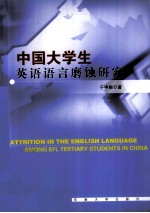
- 作 者:于中根著
- 出 版 社:南京:东南大学出版社
- 出版年份:2010
- ISBN:9787564125059
- 标注页数:205 页
- PDF页数:217 页
请阅读订购服务说明与试读!
订购服务说明
1、本站所有的书默认都是PDF格式,该格式图书只能阅读和打印,不能再次编辑。
2、除分上下册或者多册的情况下,一般PDF页数一定要大于标注页数才建议下单购买。【本资源217 ≥205页】
图书下载及付费说明
1、所有的电子图书为PDF格式,支持电脑、手机、平板等各类电子设备阅读;可以任意拷贝文件到不同的阅读设备里进行阅读。
2、电子图书在提交订单后一般半小时内处理完成,最晚48小时内处理完成。(非工作日购买会延迟)
3、所有的电子图书都是原书直接扫描方式制作而成。
Chapter 1 Introduction 1
1.1 Background to the Study 1
1.1.1 Bilingual Education 1
1.1.2 Current Status of English Language Learning in China 2
1.1.3 English Language Programs in China 4
1.1.4 Models of Mandarin-English Bilingual Education in China 7
1.2 Statement of the Research Problem 9
1.3 Purpose of the Study 10
1.4 Theoretical Framework for This Study 11
1.5 Objectives of the Study 13
1.6 Significance of the Study 14
1.7 Limitations of the Study 15
1.8 Conclusion 15
Chapter 2 Literature Review 17
2.1 Foreign Language and Second Language Learning 17
2.2 Affective Factors Influencing the Learning of a Foreign Language 19
2.3 Language Contact 20
2.4 Language Maintenance 22
2.5 Language Shift 24
2.6 Language Attrition 26
2.6.1 Definition and Taxonomy in Language Attrition 27
2.6.2 The Relationship between Language Attrition and Language Learning 29
2.6.3 Language Attrition,Code-switching,and Code-mixing 30
2.6.4 Hypotheses Related to Language Attrition 32
2.6.4.1 Initial Proficiency 32
2.6.4.2 The Threshold Hypothesis 33
2.6.4.3 Retrieval Failure Hypothesis 34
2.6.4.4 The Savings Paradigm Hypothesis 35
2.6.4.5 The Relearning Hypothesis 36
2.6.4.6 The Regression Hypothesis 36
2.6.5 Gender as a Factor Influencing Language Attrition 37
2.6.5.1 Gender Differences in Motivation 37
2.6.5.2 Gender Difierences in Language-based Abilities 38
2.6.5.3 Gender Differences in Language Attrition 39
2.6.6 Other Social Factors Affecting Attrition 40
2.6.7 Attrition of Sub-skills 41
2.6.7.1 Attrition of Listening and Reading Skills 41
2.6.7.2 Attrition of Writing Skills 42
2.6.7.3 Attrition of Vocabulary 44
2.6.8 Previous Studies on Language Attrition over Holidays 48
2.6.8.1 Rate of Attrition 50
2.6.8.2 Age as a Factor Influencing Language Attrition 50
2.7 Conclusion 51
Chapter 3 Methodology 53
3.1 Procedure of the Study 53
3.1.1 Instruments 53
3.1.1.1 Tests 53
3.1.1.2 Questionnaire 64
3.1.2 Sample 65
3.1.3 Methods of Analysis 66
3.1.3.1 Computer-aided Analysis 66
3.1.3.2 Analysis on Linguistic Representation of Vocabulary Attrition 70
3.2 Conclusion 71
Chapter 4 Results and Discussion 72
4.1 Results and Discussion 72
4.1.1 Research Question 1:Do English language skills attrite after a two-month holiday in terms of speaking,vocabulary,short conversation and passage listening,speed reading and in-depth reading,and writing? 73
4.1.1.1 Self-assessment of Overall English Proficiency 73
4.1.1.2 Speaking 75
4.1.1.3 Vocabulary 76
4.1.1.4 Short Conversation and Passage Listening 83
4.1.1.5 Speed Reading and In-depth Reading 84
4.1.1.6 Writing 87
4.1.2 Research Question 2:Are there gender differences in English language attrition after a two-month holiday? 91
4.1.2.1 Gender Differences of Attrition in Listening and Reading Skills 92
4.1.2.2 Gender Differences of Attrition in Writing Skills 93
4.1.3 Research Question 3:Are there any differences in both frequencies of social activities and levels of motivation in relation to English use before and during the holiday? 94
4.1.3.1 Motivation 96
4.1.3.2 Social Activities 97
4.2 Conclusion 98
Chapter 5 Conclusion 100
5.1 Overview 100
5.2 Suggestions for Further Research 102
5.3 Concluding Remarks 104
References 106
Appendices 127
Biodata of the Author 205
List of Tables 29
Table 1 Taxonomy of Language Attrition 29
Table 2 An Overview of Methodology 53
Table 3 Scoring Sheet for Scoring Students'Writing Performance 60
Table 4 Vocabulary Knowledge Scale 62
Table 5 Vocabulary Knowledge Scale Used in This Study 63
Table 6 Number of Participants for Each Instrument 66
Table 7 Questions on Self-assessment of English Proficiency 73
Table 8 Comparison of Self-assessment of Overall English Proficiency before and after the Holidav 75
Table 9 Comparison of Self-assessment of Speaking Proficiency before and after the Holiday 75
Table 10 Nonparametric Two-related-samples Tests of Vocabulary Knowledge Attrition 77
Table 11 Phonological Representation of the Attrited Vocabularies 78
Table 12 Morphological Representation of the Attrited Vocabularies 79
Table 13 Semantic Representation of the Attrited Vocabularies 80
Table 14 Comparison between Pre and Post Listening Test Scores(N=340) 83
Table 15 Comparison between Pre and Post Reading Test Scores(N=340) 85
Table 16 Test of Normality 87
Table 17 Attrition in Writing Skills 88
Table 18 Report of the Validity of Writing Judgments 89
Table 19 Gender Differences of Attrition in Listening and Reading Skills 92
Table 20 Gender Differences of Attrition in Writing Skills 93
Table 21 Questions on Motivation and Social Activities 95
Table 22 Comparison of Motivation Levels before and during the Holiday 96
Table 23 Comparison of Social Activities before and during the Holiday 97
Table 24 An Overview of Statistically Significant Results 103
List of Figures 33
Figure 1 Forgetting Curve 33
Figure 2 Timeline of the Administration of the Tests in the Study 54
Figure 3 The Process of the Study of Vocabulary Knowledge Attrition 63
Figure 4 The Process of the Study of Linguistic Representation of Vocabulary Attrition 64
